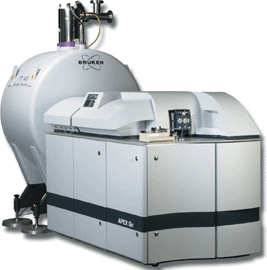|
Instrument Database:
Bruker Daltonics - apex-Qe - Qh-FTMS
| |
|

|
| |
|
| |
|
| Year of introduction |
2005 |
| Status |
historical ( out of sale ) |
| Company |
Bruker Daltonics
|
| Categories |
Hyphenated Techniques: LC-MS
Mass spectrometer: ESI-MS
Mass spectrometer: General
Mass spectrometer: LC-MS
|
Superb Resolution, Mass Accuracy
This novel combination further increases the superb resolution and mass accuracy of FTMS by using the latest proprietary high-field magnet technology, while adding facile and efficient precursor mass selection and collision induced dissociation in a conventional Qh "front end" for on-the-fly data-dependent MS/FTMS fragmentation, or selected accumulation of LC-separated protein digests.
Combining online femtomole sensitivity with ppm mass accuracy on LC-MS and LC-MS/MS data gives the specificity for even the most complex ID and de novo applications.
High Field Performance for Proteomics
The new high-field APEX-Q can deliver sub-ppm mass accuracy, enormous resolving power for peptide mixtures, wide bandwidth detection, high dynamic range, and fast automated data-dependent MS/MS for detailed proteome characterization when coupled on-line to liquid chromatography. With the APEX-Q, the life science researcher now has access to automated data dependent MS/MS functionality operating with dynamic exclusion lists, inclusion lists and other "smart" MS/MS proteomics protocols with the added benefit of FTMS caliber performance.
A powerful merger
Merging the latest quadrupole technology (complete with linear ion trapping modes), a superb multipole collision cell, together with the highest performing FTMS available is a quantum leap in capability. The combined power of the new hybrid configuration features:
LC/MS/MS with data dependent acquisition using Bruker’s simple, unified Compass software package
Exact mass MS analysis to sub-ppm levels for unambiguous determination of elemental chemical composition. Automated software to confirm composition with m/z and isotopic pattern information
Exact mass MS(n) capability for detailed structural analysis and peptide sequencing
Qh-hybrid along with CID and ECD for “top-down” proteomics (Top↓Pro™) facilitates selected gas phase ion enrichment
Extreme resolution capability for direct analysis of complex mixtures (> 600,000 FWHM)
Wide m/z range simultaneous detection of ions (e.g. 100 - 7,000 m/z)
Sub fmol sensitivity
Extended performance accessories
Magnet Choices: Bruker Daltonics offers ultra high performance actively shielded magnet technology with 7 Tesla on the standard apex-Qe system. In addition extended performance versions of apex-Qe are available at 9.4 Tesla and now 12 Tesla – the worlds highest commercially available FTMS field strength.
Performance, Versatility, Confidence: Many important analytical properties increase with the square of magnetic field strength. Capabilities such as FTMS dynamic range, center of mass collision energy and ion storage capacity show quadratic enhancement with field. With the modularity of our design, obtaining higher field strength systems from Bruker Daltonics can be done on initial order or as a magnet retrofit to existing systems on site.
Ion Source Flexibility: While FTMS is ideally suited to liquid introduction, atmospheric pressure ionization techniques such as Electrospray (standard), APCI and Nanospray, Bruker Daltonics now offers a unique integrated ESI and MALDI ion source solution – CombisourceTM. In just 60 seconds Combisource gives users the ability to switch to and from ESI and MALDI ionization with just the touch of a button. The intermediate pressure MALDI source offers exquisite sensitivity and preserves parent ion fidelity throughout the complete FTMS detection process.
Applications
Mass accuracy with absolute confidence
With the apex-Qe, high quality, exact mass measurement tools are only a mouse click away. 1ppm is routine for intact molecular analysis by MS and structural questions via MS/MS without internal standards or recalibration.
The GenerateFormula tool lists and rates possible empirical formulas consistent with the mass measurement. In addition, comparison of the entire experimental true isotope pattern of the sample with candidate theoretical profiles further validates the elemental composition.
Top↓Pro™ for top-down and bottom-up proteomics
With ECD, classic CID, and Infrared Laser Fragmentation (IRMPD), the apex-Qe brings three times more fragmentation options for the most possible structural information.
The apex-Qe combines the robust CID capabilities of the Qh front-end with the unique and powerful new Top↓Pro technology for top-down proteomics. Top↓Pro integrates the uniquely sensitive selective ion enrichment capabilities of our Qh-front-end with (ECD), and our BioTools software for top-down de Novo protein sequencing and the discovery of Post-translational Modifications (PTM’s).
Technical Data
Ion Source
Apollo ESI source or integrated ESI and MALDI ion source solution: Combisource™
Electrospray, APCI, Nanospray
MALDI-TOF standard microtiterplate design from flex series integrated
Magnets
7.0, 9.4 and 12 T magnets with active shielding
MSn Analyzer
- Routine mass accuracy with external calibration < 2 ppm and internal calibration < 1 ppm,
- mass resolution up to several 100.000.
- Extreme resolution capabilities (> 600,000 FWHM)
- Wide simultaneous detection of ions (e. g. 100 – 7000 m/z)
- Sub fmol sensitivity
- Fast MS/MS fragmentation in collision cell using CID and MSn fragmentation with IRMPD (Infrared Multiphoton Dissociation) and ECD (Electron Capture Dissociation) in Analyser cell
- Low-noise pre-amplifier and new flexible Infinity Cell Controller for higher sensitivity
Compass software suite
- Provides integrated LC/MS control and data processing, including:
- Support of widely used HPLC systems, nanoLC systems, autosamplers and fraction collectors
- apexControl for quick and easy instrument control
- DataAnalysis for data processing, including MassAnalysis accurate mass module and LibrarySearch for MS and MSn libraries
- Integration with applications-specific data interpretation packages like BioTools and MetaboliteTools
|
Related links:
|